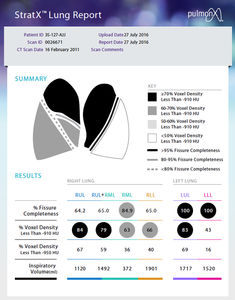
Compact multi-parameter monitor CHARTISCO2VO2-maxintensive care
Add to favorites
Compare this product
Characteristics
- Configuration
- compact
- Measured parameter
- CO2, VO2-max
- Applications
- intensive care
Description
The Chartis System is a proprietary pulmonary assessment tool that enables physicians to identify those patients likely to respond to the Pulmonx Zephyr valves with a high degree of confidence.
The Chartis System provides precise flow and pressure readings for specific lobes in the lungs to assess collateral ventilation. Clinical studies have shown that patients with low to no collateral ventilation respond best to Zephyr valve therapy.
Using the Chartis System in combination with the StratX Lung Analysis Platform, physicians can correctly identify Zephyr valve responders in approximately 90%1 of cases.
How it works
The Chartis balloon catheter is inserted through a bronchoscope to the target airway, and the balloon is inflated to block flow to the target region.
The system calculates airway resistance and measures CV in isolated lobes in the lung. The Chartis console displays expiratory air flow (orange), pressure (blue), and resistance measurements.
Collateral ventilation can limit the effectiveness of endobronchial LVR therapy1,2
Using the Chartis System to accurately assess collateral ventilation (CV) within the targeted treatment area, physicians can identify which patients are appropriate for the Zephyr valve therapy.
Expiratory airflow persists over time, indicating the presence of collateral airflow from adjacent lung compartments.
Catalogs
*Prices are pre-tax. They exclude delivery charges and customs duties and do not include additional charges for installation or activation options. Prices are indicative only and may vary by country, with changes to the cost of raw materials and exchange rates.



